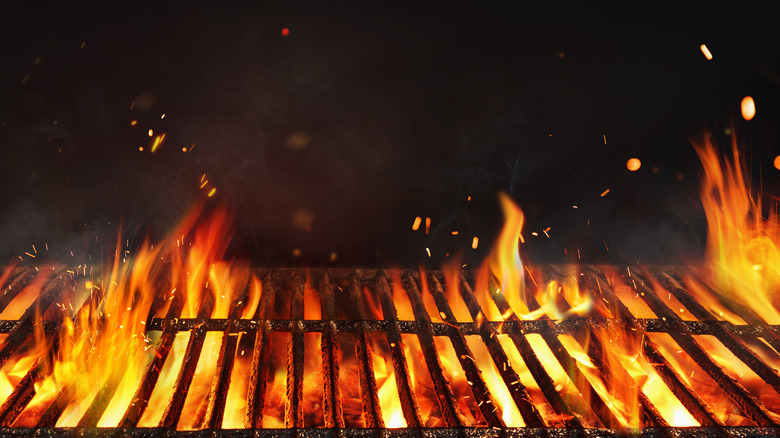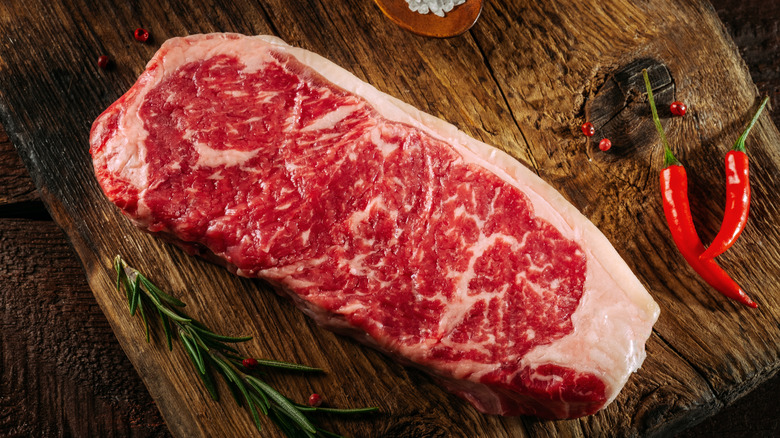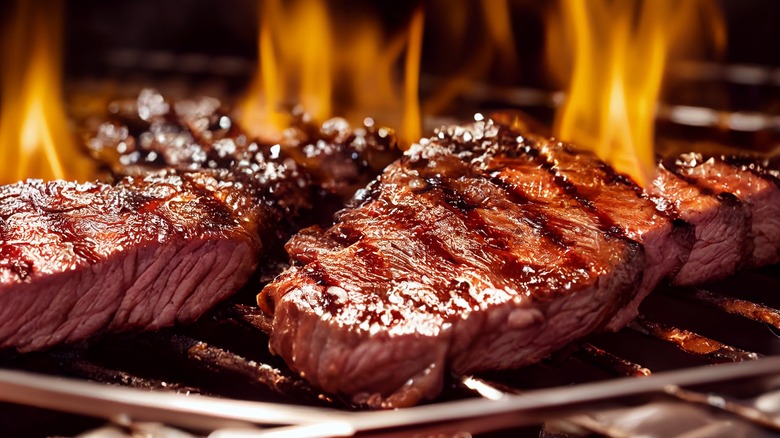The Cut Of Meat Chefs Recommend If You're New To Grilling
Something about the primal nature of grilling food makes the whole cooking and eating process hit on a deeper level. When the summer months roll around, nothing beats a cookout, no matter what you're throwing down on the grill — but let's face it, the undisputed king of grilled foods is steak. A good grilled steak is a dish every cook should have up their sleeve, but it can be a tricky ingredient to perfect. Steaks carry high stakes (pardon the pun) as they tend to be expensive, and they're best prepared with only a little seasoning, which means nothing to cover up your mistakes. For these reasons, it's so important to pick the right cut.
Not all steaks are created equal. In fact, some cuts of steak should not be grilled at all, as high heat can turn super lean segments like brisket and chuck into a dry, rubbery mess. Even filet mignon, widely prized for its blend of leanness and tenderness, can be finicky on the barbecue. If you're new to grilling, many chefs recommend honing your skills with a strip steak, also known as New York Strip or Kansas City Strip. Strip steak is friendly to the novice griller because it contains rich deposits of intramuscular fat known in meat lingo as marbling. Fat is one key to tenderness and flavor, and when working with strip steak, it's hard to go wrong on either count.
What is strip steak?
Strip steak is considered among the finest cuts, right up there with ribeye and filet mignon. In fact, strip steaks and ribeyes come from different segments of the same muscle, the longissimus dorsi, which runs along the cow's back from the hips to the shoulder blades. Cuts taken from the cow's back are more tender because they do less work. Conversely, cuts like the brisket, shank, and chuck, all taken from around the legs and shoulders, support the animal's weight and movements.
Depending on how your butcher works, strip steak may include portions of two other muscles: the multifidus dorsi and the gluteus medius. The multifidus dorsi is attached to the wide end of a strip streak and is quite desirable in its own right. However, the gluteus medius — part of the sirloin muscle — is tougher and easily identified by the large vein running through it. Generally speaking, you should avoid strip steaks with the gluteus medius attached.
Lastly, you can also find strip steaks as part of two other famous cuts: the porterhouse and the T-bone. These cuts include strip steak, tenderloin filet (the source of filet mignon), and the bone that connects them. Porthouses and T-bones are very similar, save for the fact that a porterhouse has a greater portion of the filet. It's also important to note that strip steaks with multiple muscles will have more connective tissue and intermuscular fat, which can become chewy when grilled.
How to grill a strip steak
Strip steaks are perfect for grilling because they benefit from high heat and a short cooking period, giving them a dark and flavorful crust while maintaining a tender, juicy interior. As with all steaks, take your strip out of the refrigerator at least 30 minutes before you start grilling so it can come to room temperature. This is important because a cold steak will not cook as evenly; the outside tends to blacken while the inside remains raw. You also want to pat the steak with a paper towel to remove moisture from its exterior to help it develop a proper crust.
As far as seasonings go, strip steak demands simplicity. A generous pinch of salt and pepper on both sides is all you need. Start by throwing the steaks down on the hottest part of your grill – directly over the flames — and searing each side for about 2 to 3 minutes until you achieve a dark crust. After that, you can move it away from direct heat to finish cooking — but check the temperature with a meat thermometer before serving.
The general rules for steak cooking temps advise aiming for 125 degrees Fahrenheit for rare steaks, 135 for medium-rare, 145 for medium, 150 for medium-well, and 160 for a well-done steak. As a bonus, the natural marbling of the strip should keep it moist, which means it's a very forgiving cut if you push it past your preferred doneness.


